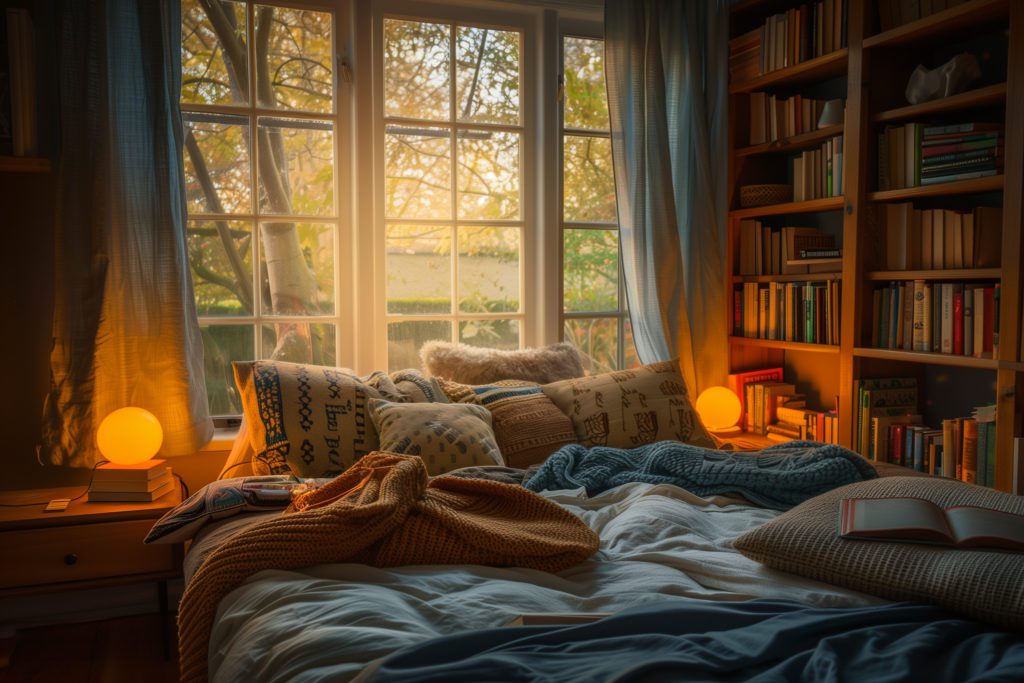
Practical Tips For Managing Sleep in Hot and Cold Weather
Struggle to sleep when it's too hot or freezing cold? Learn how to optimize your bedroom for any weather, helping you secure a good night's rest all year round

Beating the heat and chilling out—how to master sleep in any climate
Whether you're tossing and turning through a sweltering summer night or shivering until dawn in the dead of winter, extreme temperatures can turn what should be a restful night into a restless ordeal. More than causing you discomfort, the wrong temperature can disrupt your sleep cycle and impact your health.
In this article, we'll look at some simple strategies to help you maintain the perfect sleep environment, no matter what the weather forecast says. Read on to take control of your comfort and conquer sleep challenges across the seasons.
The impact of temperature on sleep
Your body’s core temperature naturally dips at night, signaling that it’s time to wind down and rest. This drop in temperature initiates sleepiness and plays a critical role in maintaining deep, restorative sleep. However, when external temperatures clash with this natural process—whether too hot or too cold—it can disrupt this cycle, making it harder to fall asleep and stay asleep.
Ideally, your sleeping environment should be around 65 degrees Fahrenheit (18 degrees Celsius), which supports this natural dip and fosters optimal sleep conditions. Deviations from this temperature can activate your body's internal thermostat, pulling you out of the deep sleep stages or even waking you up. Understanding and controlling your sleep environment’s temperature is important for improving sleep quality, allowing your body to perform its nightly reset effectively.
Getting good sleep in hot weather
Sleeping soundly in hot climates can be a nightly challenge. High temperatures can prevent the body from reaching and maintaining the ideal sleep state, as it struggles against the heat to cool down.
- Use cooling bedding: Invest in breathable, moisture-wicking sheets and pillows, such as those made from bamboo, cotton, or specialty fabrics designed to draw heat away from the body.
- Set your AC to room temp: Set your air conditioning to maintain a room temperature around 65 degrees Fahrenheit during the night. If AC isn't an option, strategically placing fans can help circulate air and create a cooler environment.
- Hydrate, hydrate, hydrate: Drinking enough water throughout the day cools the body internally and helps regulate body temperature in warmer climates. Avoid heavy meals and alcohol before bedtime, as these can raise your body temperature.
- Put up blackout curtains: Install blackout curtains to block out heat from sunlight during the day, keeping the room cooler for nighttime.
- Use temperature-regulating toppers: Consider a gel cooling pad or a specialized mattress topper to provide an extra layer of cool comfort.
In hot climates, fine-tuning your bedroom to stay cool means aligning with your body's innate rhythms for a truly restorative rest. Make these adjustments and transform your sleep experience from restless to rejuvenating.
Getting good sleep in cold weather
On the other hand, bracing for bed in colder climates can feel like gearing up for a mini expedition. But with the right setup, you can turn your bedroom into a cozy retreat that beckons even on the chilliest nights.
- Use heated bedding: Start with an electric blanket or a heated mattress pad to turn your bed into a warm haven before you even dive in.
- Layer up: Pile on the blankets—think flannel or fleece for top-notch toastiness that you can peel off if you start to overheat.
- Seal any drafts: Keep the cold out by sealing drafts around windows and doors. Heavy curtains can double as insulation, trapping heat inside.
- Set the thermostat to room temp: Aim to keep your sleeping space at a steady 65 degrees. It’s warm enough to relax but cool enough to prevent a mid-night sweat session.
- Wear thermal pajamas: Invest in some quality thermal pajamas. They’re the secret weapon for staying snug, from dusk till dawn.
Mastering these elements makes sure your bedroom is a warm bubble in the winter freeze, promoting uninterrupted sleep and keeping you comfortably in dreamland till morning.
Adapting sleep routines seasonally
Changing seasons shouldn't throw your sleep schedule out of whack. Instead, tweak your routine to harmonize with the ebb and flow of natural light, key for regulating your body's clock. Here are some quick tips:
- Harness natural light: Make the most of natural sunlight upon waking during the summer to kickstart your day. In darker months, artificial light sources like SAD lamps can mimic this effect and help maintain a regular wake-up time.
- Schedule bedtimes with the sun: Shift your bedtime slightly earlier in winter and later in summer to better match the natural light patterns, but keep the adjustment mild to avoid disrupting your overall sleep pattern.
- Set a consistent wake-up time: While bedtimes might shift slightly, aim for a consistent wake-up time. This anchors your body’s internal clock, promoting a stable sleep-wake rhythm all year.
These changes not only enhance sleep quality across seasons but also make sure you align your internal clock with the natural world, optimizing daytime alertness and nighttime restfulness.
Optimizing sleep in extreme temperatures with tech
Want to take things a step further? In today’s world, technology offers smart solutions to help you create the perfect sleep environment. Take a look at some of the latest tech that can help:
- Smart thermostats: These devices can automatically adjust your bedroom temperature based on your sleep and wake times, ensuring you’re always sleeping in comfort.
- Sleep tracking apps: Use apps to monitor how well you sleep during different seasons and adjust your habits and environment based on real data.
- Climate-controlled bedding: Consider investing in bedding that adjusts to temperature changes. These can heat up or cool down as needed, providing year-round comfort.
If you’re really set on securing good slumber, use these tools to fine-tune your sleeping conditions, making it easier to drift off and stay asleep, no matter what the thermometer reads.
Get good sleep, all year round
As we've journeyed through managing sleep across the thermal spectrum, remember: your bedroom is a climate zone you can master. Get creative with your approach, tweak your surroundings as the seasons change, and enjoy the profound impact on your nightly rest (and how you feel the next day!).

Written by
Georgia Austin
Professionally trained copywriter, editor, and content marketing strategist with over 7 years of experience—working with brands like Nike, Siemens, Toshiba, Tommy Hilfiger, Culture Trip, and Klook.
Download Pillow
Get help
Press & News
Legal
Connect
X (Twitter)
Company
Copyright © Neybox Digital Ltd.


